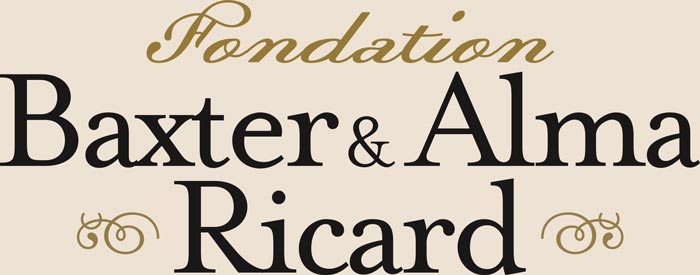D.4 Hubris
Fri Oct 20 / 15:15 – 17:00 / KC 203
chair /
- Joan Coutu, University of Waterloo
Banff: a town. Banff: named after another town in Scotland. Banff: founded as a pre-eminent Euro-American tourist destination, located in Canada’s first national park, land that is the territories of many Indigenous groups. Canada, a settler construct.…. Banff is an interesting place to explore the idea of hubris.
As defined by the OED (another inherently hubris enterprise), ‘hubris’ means presumption; pride, excessive self-confidence. While the description above speaks to hubris in imperial-settler built environments, hubris comes in many guises – through content, types of media, etc. – and often aligns with utopia, exceptionalism, habitus, gender, and more. By foregrounding hubris, the aim of this session is to register and unpick its insidious and persistent presence. Four speakers will provide 10-minute rapid-fire case study presentations, followed by a 30-minute roundtable discussion.
keywords: hubris, media, utopia, exceptionalism, presence
session type: combined format
Joan Coutu is professor of Art History and Visual Culture at the University of Waterloo. Her research concentrates on built environments of the eighteenth-century British empire and its colonies and Canada around the turn of the twentieth century. Monuments, sculpture, buildings, and town design are considered in the contexts of imperialism, politics, time, and identity. Her publications include two sole-authored books, Persuasion and Propaganda: Monuments and the Eighteenth-century British Empire (2006) and Then and Now: Collecting and Classicism in Eighteenth-century England (2015), and a co-edited interdisciplinary volume of essays with Jon Stobart and Peter Lindfield, Politics and the English Country House, 1688-1800 (2023). She is currently editing another volume of essays with David Galbraith, entitled Utopia and Hubris: Classicism in Canada, c. 1900-1950 (anticipated 2024).
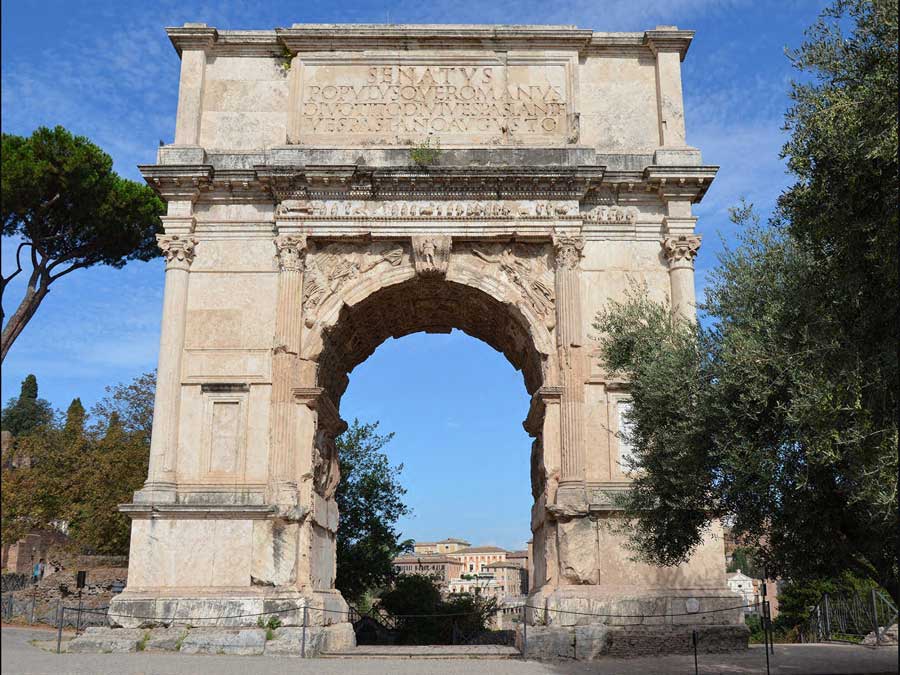
Arch of Titus, Rome, 81CE (C. Raddato, WikiCommons)

Delhi Memorial (India Gate), New Delhi, 1921 (A. Savin, WikiCommons)
Hubris and the Arches of Republican Rome
- Anne Hrychuk Kontokosta, Institute of Fine Arts, New York University
The freestanding Roman arch, conventionally a “triumphal” arch, is one of the most iconic monuments of the ancient world. During the imperial period (1-5c CE), over 800 arches were commissioned throughout the Mediterranean (Fähndrich 2005). The earliest arches (“fornices”) were constructed in Rome during the Middle Republic (3-2c BCE). Set up by victorious generals who were denied the celebration of a Triumph (a vital socio-political milestone for elite males), these arches are conventionally decoded as pious “votive” monuments, constructed to honor the gods (Kleiner 1985; DeMaria 1988). Traditional narratives identify Augustus, Rome’s first emperor, as the originator of the militarily-charged and self-aggrandizing triumphal arch.
This paper reconceives the early Roman arch as a fundamentally hubristic monument, deliberately designed to replace the official, but ephemeral, Triumph. I argue that early patrons manipulated established systems of triumphal honors and manubial building to construct monuments that glorified themselves and their families. Set at significant urban nodes along the triumphal route, these arches acted as massive statue bases, raising gilded images of their patrons high above other honorific statues of ancient Rome. Their design was innovative: the form replicated the Porta Triumphalis, the sacred gate through which only victorious armies could pass, while their permanence and position forced triumphal generals to parade past, or even through, arches adorned with the glittering statues of rivals. These self-aggrandizing origins are critical to post-antique conceptions of arches as symbols of both imperialism and individual military exceptionalism, today still echoed from New Delhi, to New York, to Pyongyang.
keywords: hubris, Roman, architecture, arches, triumph
Anne Hrychuk Kontokosta is a Visiting Scholar of Roman Art and Archaeology at the Institute of Fine Arts, New York University. Her work focuses on diachronic convergences between architecture and urbanism; mapping, memory, and the meaning of ancient monuments; public art in urban contexts; Roman sculpture in ancient contexts; and post-antique buildings and their ancient models. Her publications address Greek and Latin epigraphy, Roman sculpture, Roman architecture, and Roman urbanism. While much of her research concentrates on the city of Rome and its urban development over the longue durée, her interests also include Rome’s western provinces and the Greco-Roman East. Anne holds a MA and PhD in Classical Art and Archaeology from the Institute of Fine Arts at NYU, studied classical languages at the University of Pennsylvania, and earned a BA in Anthropology and Classics from the University of Alberta. She lives in New York City and Canmore, Alberta.
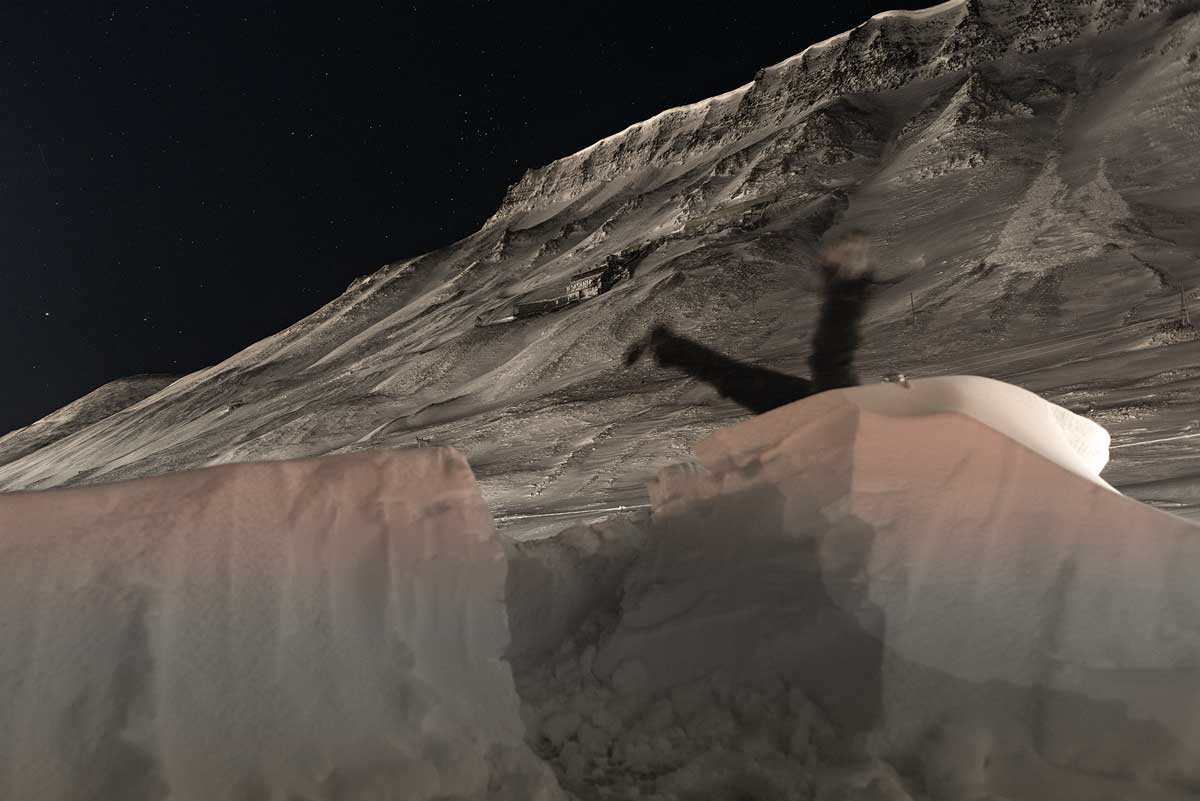
Risa Horowitz, from Practicing Standing, documented performance atop Galleri Svalbard, Winter 2018
Out of this World (again)…
- Risa Horowitz, University of Regina
In August 2024 I will return to the Arctic for the fourth time. In 2017/2018 I attended two residencies in Svalbard—one aboard a barquentine ship, another at the world’s northernmost contemporary art gallery, where I returned for a solo exhibition. Svalbard has no historical Indigenous human population, but for 500 some years humans have exploited its natural resources (whales, bears, coal, tourism etc.). Next year, I will conduct several self-designed and given instructions for performance, documented to photo and video, addressing the dissonances and complexities of Arctic touring during a time of ecological crisis, employing processes that meaningfully examine the value of my own power, privilege, and subject-position. I paused for a heartbeat before committing to return to this fragile part of the planet. But I will go, and both confront and address my own environmental impact (while attempting to avoid making didactic eco-art). My performances will leverage both humour and humility (eg. hosting a ship-board karaoke event; being the world’s northernmost roller skater), but not be pure whimsy. Self-deprecation and absurdity will be important rhetorical tools for me. This summer I will be inviting close to 100 artists and curators to contribute instructions for me to perform. Invitees are not random, but those with whom I have shared tender and critical exchanges about art, memorial, elegy, witness, mortality, pathos, and, yes hubris. In Banff, I wonder if I can expand upon my thinking and planning, and possibly deconstruct some of the instructions I will have received by then?
keywords: arctic, performance art, eco-tourism, documented performance, perimenopause
Risa Horowitz is a Professor in the Department of Visual Arts, Faculty of Media, Art, and Performance at the University of Regina. Blurring boundaries between expert-amateur, hobby-work, and leisure-productivity, much of her work involves collecting and durational practices that pay attention to time and its representation. Horowitz has exhibited widely in Canada and abroad, with works held in public and private collections. She was the 2022-2023 Research Fellow with the University of Regina Humanities Research Institute, developing her projects Urban Erratics, Piles of Things, and Other Landscape Observations for photo, video, and immersive video display. In August 2024 she will have the hubris necessary to return to Svalbard for the fourth time, where she will conduct a set of devised and given documented performances.
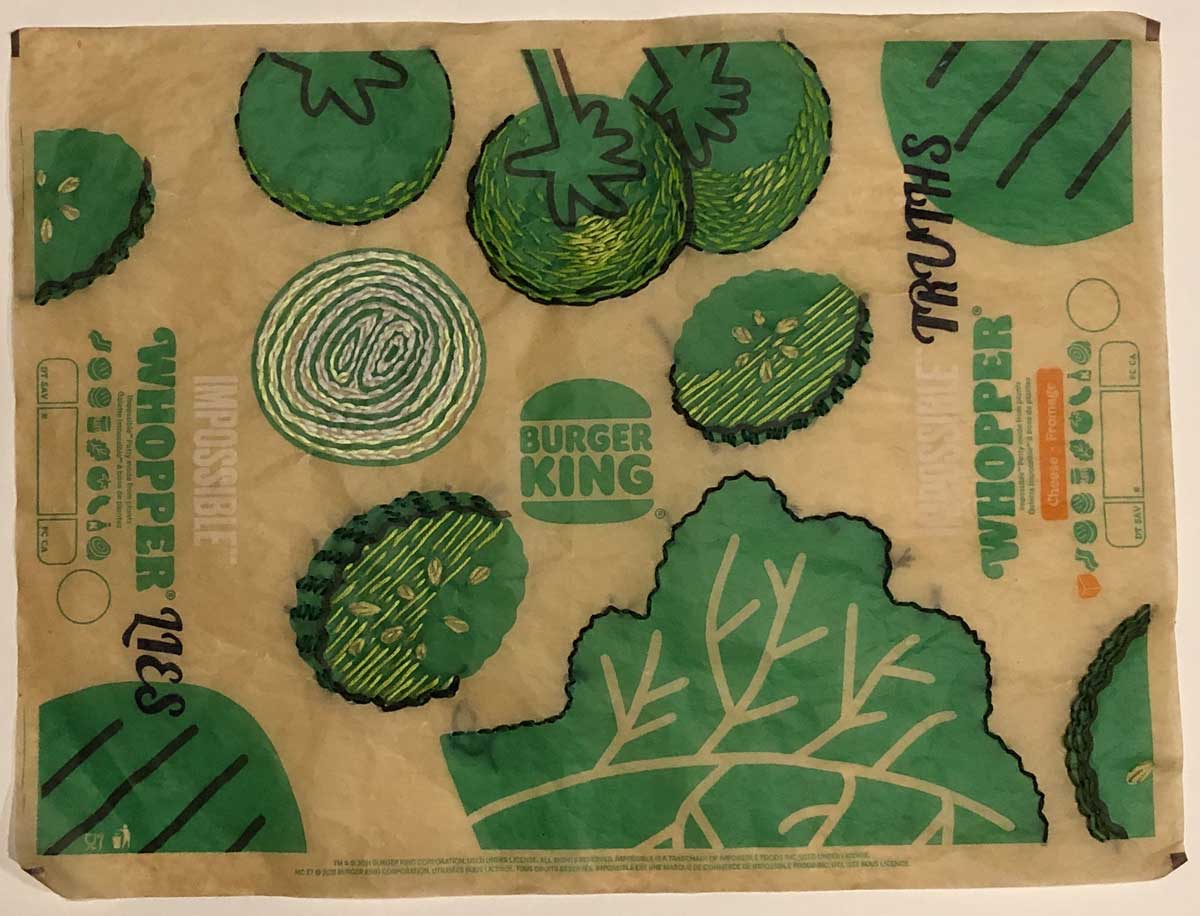
Tanya Klimp, Green Wash (in progress), burger wrapper, ink and embroidery thread, 16” x 12”, 2023
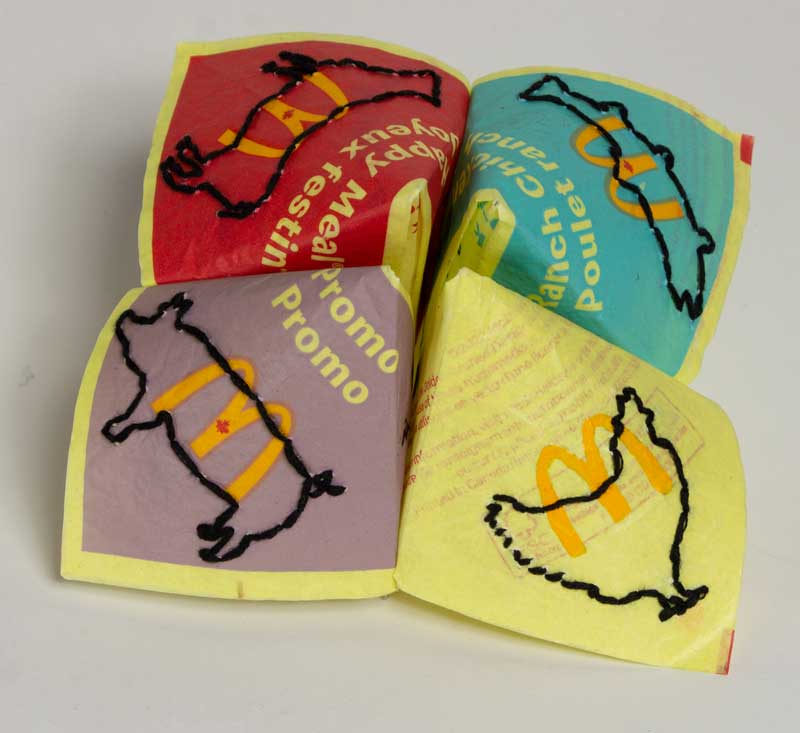
Tanya Klimp, Fortune Teller, burger wrapper, ink and embroidery thread, 6” x 6” x 3”, 2023
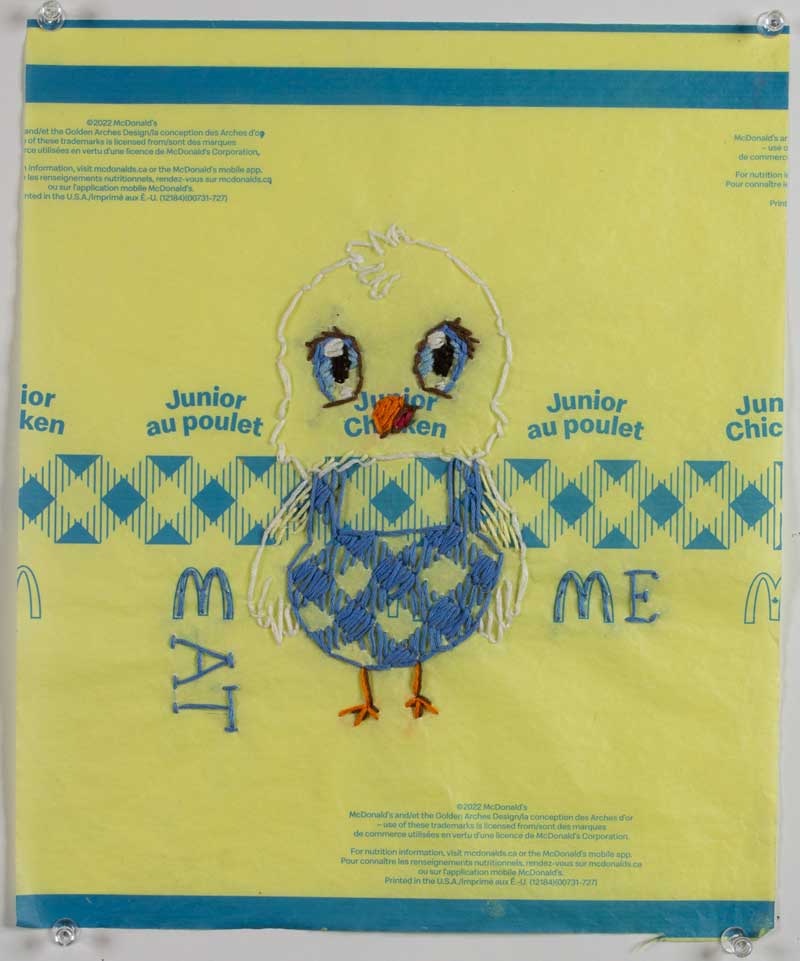
Tanya Klimp, EAT ME, burger wrapper and embroidery thread, 10” x 12”, 2023
Hubris in Art: Fast-food
- Tanya Klimp, University of Alberta
Fast-food: instant gratification for hunger. Fast-food: a commodity that has velocity, distance and mass, lacing the planet with franchises and weighty carbon footprint. Fast-food: perhaps one of the most powerful symbols of humans’ dominance on this planet. Fast food wrappers are representative of consumerist society and its associated hubris. By unpacking these ubiquitous wrappers, we may better discuss the impact of hubris on individuals, communities, and the environment.
As part of the pantheon of global visual culture, the wrappers act as a calling-card for imperial-settler hubris. They are loaded with an explicit purpose, but silently contain other conversations. The printed burger wrapper is a 20th century prodigy, birthed from capitalist ideals. The intrinsic nature of fast-food restaurants is to conquer, as seen in the number of franchises globally, stock value, control of resources (even those of other sovereign nations), food addictions in the populace etc. These companies follow an exceptionalist model of ever increasing production. A moderate level of success is not enough. It is about control.
My interest in fast-food wrappers is to haptically explore these by-products. I embroider onto them in a slow attentive manner. Questioning both the habit and habitus that initially created them but seeing how they in turn frame the aforesaid. Reframe, zoom in, reframe, zoom in. These thin skins of consumerism are both media (as material matter) and medium (as something that is spoken through). In my art practice I disrupt the process, inverting the wrappers with conversations about the hubristic nature of consumerism.
keywords: hubris, consumerism, colonialism, agency, disruptive
Hello. My name is Tanya Klimp, and I am a Masters of Fine Arts painting candidate at the University of Alberta. I consider myself a maker, and I love the materials and my tools. Experimenting with unconventional items has been rewarding. In terms of art, if I were to distill and define my investigation — it would be best labeled as Form and Content. I am interested in questioning what constitutes either of those, what relevance they contain and why, in seeking new possibilities, and opening discourse around them. I have environmental, feminist and socialist concerns. I co-parent and collaborate with my queer partner to raise our two teenage children. He is also an artist (working on his own Masters concurrently!). I enjoy Donna Haraway’s sympoeisis and tentacular thinking, Jane Bennett’s ‘thing’ agency, Roland Barthes’ myth-making, Julia Kristeva’s embracing the abject, Deleuze and others' conversations about decentralized connectivity or algorithm theory.
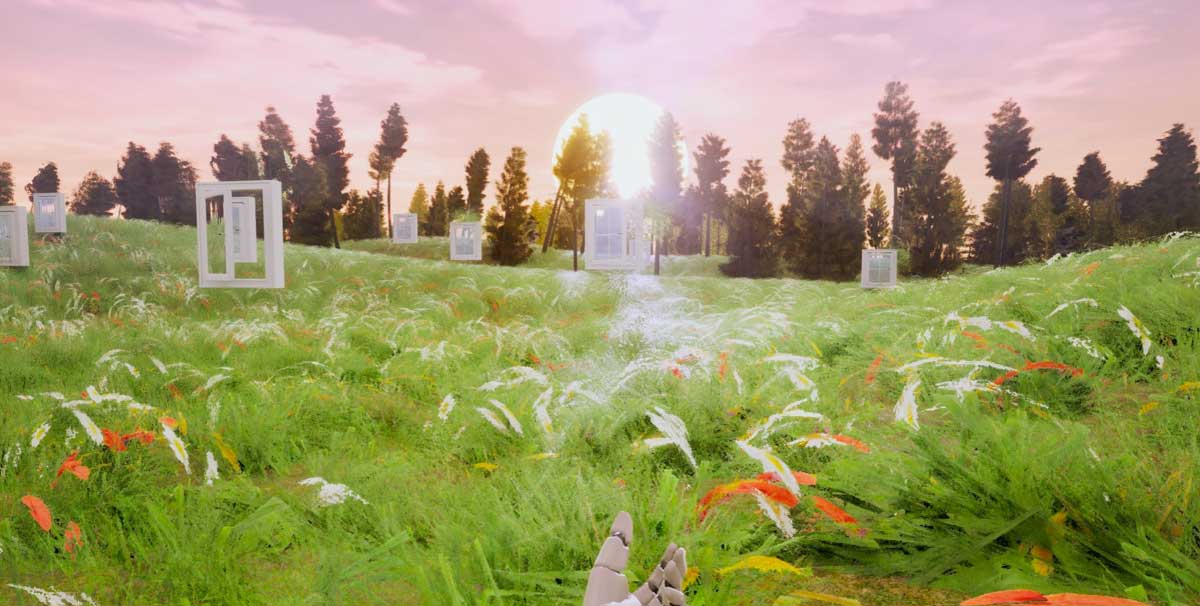
Ludmila Lima De Morais, Wind symphony, printscreen of gameplay in unreal5, 2023

Ludmila Lima De Morais and Dall-e, ai generated digital image 2023
I am not a Robot (?)
- Ludmila Lima De Morais, University of Alberta
Delves into Ludmila Lima de Morais' captivating projects, Second Sun and Wind Symphony, within the intriguing context of hubris in visual culture. Here the artist explores notions of utopia, exceptionalism, habitus, and beyond.
The project Second Sun introduces a robotic sunflower that dynamically follows viewers using facial recognition technology. Ludmila's creation, comprising a Raspberry Pi 4, servo motors, a USB camera, and an OpenCV face tracking code, symbolizes humanity's desire to be the center of nature. However, the project also raises important questions about the potential surveillance of immigrants, revealing the complex relationship between humans, nature, and technology. With these interactions, Ludmila sheds light on the darker aspects of our reliance on technology and our impact on the natural world.
Inspired by personal experiences, Wind Symphony explores sound's transformative power. Ludmila's 3D environment, constructed using the Unreal Engine, immerses participants in a post-apocalyptic dreamscape featuring floating windows, pine trees, and spinning wild grass flowers. By collecting wind howling sounds and creating a personalized wind symphony, the project challenges preconceived notions of fear and anxiety associated with the wind. This artistic endeavor aims to shift perceptions, turning the sound of the wind into a source of beauty, creativity, and wonder. Simultaneously, Wind Symphony underscores the importance of our relationship with nature, reminding us of the fragility of our planet and the urgency to preserve it for future generations.
Ludmila's art traverses the intersection of technology and humanity, illuminating the complex dynamics and consequences of this relationship. By creating a sense of unease, her work prompts viewers to contemplate the implications of our treatment of nature and reliance on technology.
keywords: intermedia, art, robot, game, technology
Ludmila Lima de Morais is a Brazilian artist pursuing a Master of Fine Arts in Intermedia at the University of Alberta in Edmonton. With a passion for Intermedia, Technology, and Sound Art, Ludmila's work draws inspiration from science fiction. Her artwork explores the unsettling relationship between humans and technology, often taking on a toy-like appearance with underlying themes that are strange and uncomfortable.
Experimenting with AI technology, robotics, sound, and game engines, Ludmila creates immersive and thought-provoking installations. Her research involves collecting sounds, images, and videos from daily life, investigating the hybridizations of languages, everyday experiences, affections, and unorthodox sound compositions. Ludmila's pursuit of meaningful and evocative art has led to recognition, including winning the SSI Moses Asch Student competition with her work Resound. Through her artistic practice, Ludmila seeks to challenge traditional notions of art, provoke contemplation, and blur the boundaries between the real and the virtual.
